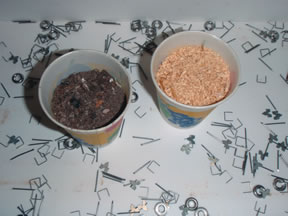
288
All the battery-powered vacuums were tested with brand-new batteries charged to their makers’ specs and brand-new filters. We put them through a series of simple bench tests and real-world use.
The bench tests began with measuring each vac’s starting voltage after allowing the batteries to settle for a few hours after charging. Next, we went through three timed tests for each vacuum. In a shallow, rectangular box made of StarBoard, we spread a half-cup combination of brads, glazier’s points, cup washers, and staples, and clocked each vacuum’s performance in picking them all up. After that, testers repeated the process with full cups of sawdust and drill shavings, and finally with cups of ash from a woodstove. (Stove ash is hell on filters and mechanisms.) All filters were cleaned between each round. For the plug-in vacs, we used a DC power-supply with a 13.8-volt output. We took noise readings for all vacuums from an arm’s length away. (See Value Guide on page 16 for results.)
After the those initial trials, testers repeated the challenge of sucking up the metal bits to see whether there would be any performance loss from filter clogging or battery drain. There were no losses; in fact, in most cases, the cleaning times improved—which probably says more about vacuuming technique than vacuums.
Testers re-checked battery voltages and found that none of the batteries had dropped more than a few tenths of a volt. The Ryobi battery showed a loss of only .6 volts (from 20.7 to 20.1), after running all three Ryobi vacs with a couple of short charging periods during the tests to keep the playing field level.
None of the batteries was any the worse for wear after these short exercises, so we recharged them all and had a battery exhaust-a-thon, running them for one-minute intervals with a break in between to let the batteries settle. The batteries from Milwaukee, Ryobi, and Makita were all Li-Ion, and all carry cutoff circuitry to stop them before they are damaged with too deep a discharge. Black & Decker and DeWalt are parts of the same company, and we were interested to see that their Ni-Cad batteries performed identically, and beat the Li-Ion pack in the one-minute test cycles. It should be noted that the Makita battery (1.5 Ah) is about 50-percent the size of the other batteries, which are about the size of a half-brick.
All of this experimental bench-testing was preliminary to a spate of real-world testing, done mid-winter on the Connecticut shore aboard a 38-foot Young Brothers lobsterboat that had been hauled up on a marine railway for a cabintop extension project. We did coddle all the batteries a bit, including the Group-24 deep-cycle 12-volt battery used to power the plug-in vacs, by charging them in a warm office. But the vacuums had it rough: sawdust, bilge mung, unidentifiable grunge—the usual detritus found around a boat project—and cold, battery-numbing weather.
After all the dry testing was done, the wet/dry vacs were put through their paces sucking up fresh water from a baking pan, a liter apiece for the RoadPro, DeWalt, Milwaukee, and Ryobi canister vacs, and a pint for the Ryobi P710. All performed very well. We’ve always been leery of using wet/dry vacs to clean up what a sponge could pick up, but at least in the wintertime, the wet/vac is a whole lot easier on the hands.



































